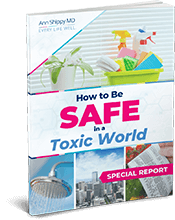One of my roles as a Functional Medicine doctor is to be a health detective. When someone comes to me with a multitude of symptoms, I begin by uncovering the root cause (or causes) and it is important to determine the role that toxins, including mold, play in a variety of health conditions (and even cancer).”
While conventional medicine might not even have mold on its radar, I’ve found that the indoor living and working conditions of my patients is extremely important to address. After all, most of us spend the majority of our days and nights inside.
Mold Toxicity can be challenging to diagnose and difficult to pinpoint the source, but when a person can change their living conditions and effectively detoxify, I’ve seen incredible healing.
In this article, I take a deeper dive into the health effects of mold and what you can do about it.
Keep reading to learn:
- What is mold toxicity
- What health problems does mold toxicity cause
- Links between mold and cancer
- Functional Medicine solutions for mold toxicity recovery
Mold Toxicity
Mold is a fungus that grows in filaments and produces spores. Some molds produce toxins, mycotoxins, that are absorbed through the skin or GI tract or enter the body through breathing. Stachybotrys chartarum is a famous toxic mold, also referred to as “toxic black mold.”
But mold doesn’t have to be black to be toxic; it can be any color, which is why testing is key for mold identification.
Mold toxicity (or mold sickness or mold illness) refers to the numerous health conditions and symptoms that are related to exposure to toxic mold and water damaged buildings.
To make it a little more complicated, mold toxicity can also be caused by other toxin-producing organisms besides just mold. These include fungi, actinomycetes, mycobacteria, and bacteria.
The toxins they make can be classified into mycotoxins, endotoxins, inflammagens, beta-glucans and mVOCs (mold volatile organic compounds).
Mold in food can also produce mycotoxins such as aflotoxins, that when ingested can be absorbed in the digestive tract.
The toxins that these organisms can produce are poisonous and on the same scale as heavy metals, formaldehyde, pesticides, dioxins and other environmental contaminants that wreak havoc on our health.
Some mycotoxins have even been used in biological warfare!
Mold can be found almost anywhere including the home, workplace, cars and in schools, and effects can be cumulative. Some may not notice any effects until the toxin buildup is too much for the body to handle.
Others are more sensitive to mold because of genetics, toxic load and other factors. Those who are more sensitive may be the “canary in the coalmine” alerting that there is a mold issue in an indoor environment.
Those who are immunocompromised or have a chronic health condition may be at higher risk for mold toxicity and infection.
What Health Problems Are Caused By Mold?
Symptoms of mold toxicity may seem unexplained as well as persistent. It’s not uncommon for someone to see a host of doctors and complete many tests that turn up “normal” or for mold toxicity to be misdiagnosed.
Because mold can be hard to find, testing is required. I recommend testing for toxins in both the home and the body. My “Could it Be Mold?” fact sheet has a list of resources for testing.
Mold Toxicity Symptoms
Some of the Symptoms of mold exposure include:
- Reduced memory and cognitive decline
- Headaches
- Neurological issues – slow blink reflex, low grip strength
- Joint pain
- Autoimmune disease
- Muscle twitches (fasciculations)
- Weight change
- Asthma and allergies
- Fatigue and weakness
- Alopecia (hair loss)
- Abdominal pain, nausea, bloating,
- Changes in vision
- Vertigo, dizziness
- Depression
- Stress and Anxiety affecting Limbic system
- Birth defects
The Cancer Connection – Can Mold Cause Cancer?
Over time, mold exposure can lead to chronic disease, including cancer. This connection is often overlooked in medicine as a contributing risk factor because few are asking these questions!
Unfortunately, these toxins suppress the immune system in a way that allows for the development of cancer.
I’ve written extensively on my blog about other toxin exposures being linked to cancer. Here are a few articles from my archives:
- Alcohol and cancer
- Chromium 6 and cancer
- Recombinant bovine growth hormone, glyphosate, flame retardant and cancer
Since we know that many other toxins are linked to cancer, it makes sense that toxins produced by mold would be too. Exposure to mycotoxins can cause direct cellular damage and create changes in gene expression that can lead to multiple disease states, including cancer.
There is a significant body of research that makes the link between aflatoxins and liver cancer.
Aflatoxins are a type of mycotoxin that is often present in moldy food. The contamination happens when the food is being grown, stored, and packaged and is found in all climates but especially tropical and sub-tropical climates, which provide the enhanced conditions for mold growth.
The most common food products that can be contaminated with mold are:
- Peanuts
- Grains
- Corn
- Nuts and seeds
- Coffee
- Chocolate
- Dried fruits
- Milk, cheese, butter
These are staple foods in many parts of the world and are also used as animal feed.
When human eats enough aflatoxin – either directly or indirectly by eating animals or milk that have been fed aflatoxin-contaminated feed – liver cancer can result. And food contamination can put an entire population at risk. In Bangladesh, for example, 43.9% of liver cancer cases are due to aflatoxin.
Studies have shown a correlation between aflatoxin and liver cancer since the 1960s and there has been quite a bit of research on the topic since.
It is now understood that as the liver tries to detoxify aflatoxin, intermediate chemicals are created that are both mutagenic and carcinogenic. One study states “aflatoxins are among the most potent mutagenic and carcinogenic substances known.”
Aflatoxin also affects the tumor suppressor gene, so the body isn’t able to appropriately identify and eliminate cells that become cancerous. The result of long-term exposure can cause hepatocellular carcinoma, or liver cancer.
But it seems that acute exposures can bring risks as well. Risks increase for those with hepatitis B, as they are more susceptible to the effects of aflatoxins.
Mold Toxicity Solutions
If you have mold in your home or are suffering from symptoms of mold toxicity, if you haven’t already tested your home (or workplace), be sure to find the source of the mold so you can effectively remove it.
First things first: fix water leaks immediately and hire an expert in mold remediation. Get out of the house and relocate until it is safe to return.
My Mold Toxicity Workbook is an excellent resource and will walk you through my Functional Medicine approach to healing your body and recovering from the effects of toxic mold.
Here are some of the diet and lifestyle strategies I use with my patients who are working on mold recovery:
- Low Mold Diet: also known as Dr. Shippy’s Every Life Well Paleo protocol, is naturally low in the foods that are most likely to be contaminated with mycotoxins including grains, corn and peanuts. This diet goes a step further by also reducing the overall toxic load that your body is exposed to by focusing on organic produce and organic or pastured animal products and cooking fats.
- The fewer toxins you introduce in your food, the more your detoxification systems are able to work on clearing mold toxins. My Paleo approach is also incredibly nutrient dense, supplying the key amino acids, vitamins, minerals and plant compounds needed to support liver detoxification.
- Further, by adding in a functional food, such as my Paleo Detox Protein, you’ll be providing even more of the important detoxification-supporting nutrients than you are able to get from your diet alone.
- Support Detoxification. You might be surprised to learn that detoxification is about more than just supporting the liver. The lungs, kidneys, skin and colon all play important roles as well. Here are some of my favorite practices for detoxification support.
- Sweating – An infrared sauna or even hot Clear + Restore Bath can both support sweating and detoxification through the skin.
- Exercise – Exercise is another way to sweat as well as improve blood circulation. Exercise can also decrease the risk of cancer, for many reasons including the possibility of its role in detoxification.
- Meditation and breathing – Since we can release toxins through our breath, focused deep breathing is helpful for detoxification, not to mention stress reduction and bringing the body into a more relaxed state where healing is optimized.
- Supplemental Support. In addition to diet and lifestyle strategies, supplements are one of my most trusted tools to support the body in mold recovery, and I tailor the approach to each individual patient. Here are some of the supplements I often recommend:
- Liposomal Glutathione is one of the most crucial and helpful forms of detox support. Glutathione is the body’s most powerful antioxidant and plays an incredibly important role in detoxification. The liposomal form of glutathione is more bioavailable and better absorbed than other forms.
- GI Detox is a binder containing a combination of clay and activated charcoal to effectively sequester toxins in the GI tract and eliminate them from the body.
- Liver Detox Protect is formulated with selenium, milk thistle, alpha-lipoic acid and n-acetyl-l-cysteine to provide the liver extra support with detoxification and help to protect and repair liver cells themselves.
- Toxin Clear is another detox support supplement that I often recommend to help bind up toxins so they don’t damage the body.
Because I see mold toxicity so often in my practice, I’ve also put together a Mold Recovery Kit with some of these key supplements, along with laundry and household cleaning products to help fully clean mold, mold spores and toxins out of your home.
Conventional medicine isn’t talking about mold, but from my clinical experience it is an incredibly important topic— and mold toxicity is much more common than you may think.
Considering mold, along with other toxin exposures my patients may face, allows me to truly uncover the root cause of their symptoms and help them recover their optimal health.
Have you been exposed to toxic mold?
Are you struggling with how to address it and where to go for help?
I’ve curated and consolidated all my mold-related resources into this comprehensive MOLD HUB page, designed to assist and support you on your path to healing.
This page includes information on how to test your body and your home for toxic mold, a free guide on how to determine if mold is causing your symptoms, diet, supplements and other lifestyle tools to support detoxification and healing, my Mold Toxicity Workbook, articles and podcasts on toxic mold and related illnesses as well as an FAQ section.
Resources and tools will update and change, so be sure to bookmark this page and check it periodically.













